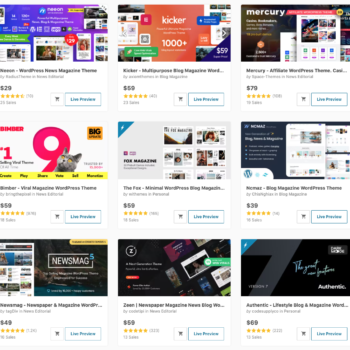So, you’re thinking about starting a blog? That’s awesome! Whether you’re dreaming of sharing your travel adventures, showcasing your culinary creations, or offering expert advice on a topic you’re passionate about, blogging can be an incredibly rewarding way to express yourself and connect with others.
Now, if you’re anything like most first-time bloggers, you’re probably feeling a mix of excitement and maybe a little bit of “Where do I even start?” Don’t worry, we’ve all been there. The good news is that starting a blog is easier than you might think, and with the right guidance, you’ll be up and running in no time.
In this guide, we’re going to walk you through every step of the blogging journey, from finding your niche and choosing a platform to creating content that people will actually want to read. We’ll share tips, tricks, and resources to help you avoid common pitfalls and set your blog up for success.
So, grab your favorite beverage, get comfy, and let’s embark on this exciting adventure together! By the end of this guide, you’ll have all the tools you need to launch your blog and start sharing your unique voice with the world.
Finding Your Niche for the First Time
Now that you’ve taken the plunge into the blogging world, it’s time to find your special corner of the internet – your blogging niche. Think of it as your blog’s unique personality, the thing that sets it apart from the millions of other blogs out there. Choosing a niche isn’t just about picking a topic you like; it’s a strategic move that can make or break your blog’s success.
Why Your Niche is Your Blogging Superpower
Choosing a niche isn’t just about picking a topic you like; it’s a strategic decision that can make or break your blog’s success. Here’s why:
- Targeted Audience: A niche helps you zero in on a specific group of readers who are passionate about the same things you are. This means more engagement, loyal followers, and a higher chance of turning readers into raving fans.
- Focused Content: When you have a niche, your content becomes laser-focused. You’ll be known as the go-to expert on your chosen topic, making it easier to create valuable content that resonates with your audience.
- Easier Monetization: A well-defined niche opens doors to monetization opportunities. You can promote products or services that are relevant to your audience, making affiliate marketing, sponsored posts, or even creating your own products more effective.
If you’re struggling to pinpoint your ideal niche, our comprehensive guide on everything about blogging offers valuable insights and exercises to help you discover your passion and expertise.
Brainstorming Your Niche: Unleash Your Passion
Finding your niche is a journey of self-discovery. It’s about tapping into your passions, skills, and experiences to create a blog that truly reflects who you are. Here are a few questions to get you started:
- What are you genuinely passionate about? What topics could you talk about for hours on end?
- What are you good at? What knowledge or skills can you share with others?
- What problems do you or others face? Can you offer solutions or advice through your blog?
Don’t be afraid to think outside the box and explore different ideas. The most successful blogs are often built on unique and unexpected niches.
Researching Your Audience: Know Your Tribe
Once you have a few niche ideas, it’s time to do some research. Is there an audience for your niche? Use keyword research tools to see how many people are searching for topics related to your niche. How crowded is your niche? Look at other blogs in your niche to see what they’re doing well and where there might be gaps you can fill.
Remember, you’re not just looking for any audience; you’re looking for your tribe – people who share your interests and values. To chart a course for success in your chosen niche, consider following our blogging roadmap for step-by-step guidance.
Narrowing Down Your Niche: Finding Your Sweet Spot
If your niche is too broad, it will be hard to stand out. Try to narrow it down to a more specific sub-niche. For example, instead of “food blog,” you could focus on “vegan recipes for busy professionals.”
Crafting Your Niche Statement: Your Blog’s Mission
A niche statement is a one-sentence summary of your blog’s focus. It should be clear, concise, and specific. For example, “I help busy professionals cook delicious and healthy vegan meals in under 30 minutes.”
Finding your niche is an exciting step in your blogging journey. It’s your chance to create a unique space on the internet where you can share your passion, expertise, and creativity with the world.
Choosing Your Blogging Platform and Domain Name for the First Time
The first big decision you’ll face as a new blogger is choosing a blogging platform. This is the software that will power your blog and make it easy for you to create and publish content. There are many different platforms out there, each with its own pros and cons.
Popular Blogging Platforms for First-Time Bloggers
Some popular options for first-time bloggers include:
- WordPress: This is the most popular blogging platform in the world, and for good reason. It’s incredibly flexible, customizable, and offers a vast array of plugins and themes to help you create a unique and professional-looking blog.
- Blogger: This is a free platform from Google that’s easy to use and great for beginners. However, it’s not as customizable as WordPress and has limited features.
- Wix: This is a website builder that also offers blogging capabilities. It’s known for its drag-and-drop interface and beautiful templates, but it can be less flexible than WordPress.
- Squarespace: This is another website builder with blogging features. It’s similar to Wix in terms of ease of use and design, but it can also be more expensive.
For most new bloggers, I highly recommend WordPress. It’s the platform I use for Simple Blogger, and it’s the platform that powers millions of other successful blogs around the world. It’s user-friendly, even for beginners, and it offers the flexibility and scalability you need to grow your blog over time. If you’re ready to take the leap and start your blog, our guide on how to start a blog will walk you through the process step-by-step.
Your Blog’s First Address: Choosing a Domain Name
Once you’ve chosen your platform, it’s time to pick a domain name. This is your blog’s unique address on the internet, like www.yourblogname.com. Your domain name should be:
- Relevant to your niche: It should give readers an idea of what your blog is about.
- Brandable: It should be easy to remember and pronounce.
- Available: Make sure the domain name you want isn’t already taken.
You can register your domain name through a domain registrar like Namecheap or GoDaddy. Many hosting providers also offer domain registration services. For tips on choosing a domain name that sticks, check out our guide on selecting a memorable domain name.
Setting Up Hosting for Your First Blog
In addition to a domain name, you’ll need hosting. This is where your blog’s files will be stored and made accessible to the world. Think of it as renting space on the internet for your blog to live.
There are many different hosting providers to choose from, so do your research and compare features and prices before making a decision. Some popular options include Bluehost, SiteGround, and HostGator.
Once you’ve chosen a hosting provider, you can usually install WordPress with just a few clicks. Most providers offer one-click WordPress installation, making it easy to get your blog up and running quickly.
With your platform, domain name, and hosting sorted, you’ll have the technical foundation in place to start building your blog. In the next section, we’ll dive into designing your blog and making it visually appealing to your readers.
Designing Your Blog for the First Time
Now that you’ve got the behind-the-scenes stuff sorted, let’s make your blog a feast for the eyes. Think of it as decorating your new home – you want it to reflect your personality and make your guests feel welcome.
Choosing a Theme or Template: Dressing Your Blog for Success
Your blog’s theme is like its outfit. It’s the first thing people notice, and it sets the tone for their entire experience. When choosing a theme, think about the vibe you want to create. Are you going for a minimalist, modern look? Or maybe something more playful and colorful?
There are thousands of free and premium WordPress themes available, so take your time browsing and find one that speaks to you. Remember, it’s not just about looks – the theme should also be functional and easy to navigate. And with more and more people browsing on their phones, make sure it’s mobile-friendly too!
Customizing Your Design: Adding Your Personal Flair
Once you’ve found the perfect theme, it’s time to add your personal touch. This is where you can let your creativity run wild! Think of it as accessorizing your outfit. You can change the colors, fonts, and layout to match your brand and style.
Don’t forget about your logo! It’s like your blog’s signature, so make sure it’s unique and memorable. You can create your own or hire a designer to help you.
Essential Pages for Your First Blog: The Must-Haves
Every blog needs a few essential pages to provide information and build trust with your readers. Think of them as the rooms in your blog’s house:
- About Page: This is where you introduce yourself and your blog. Share your story, your mission, and what readers can expect from your content.
- Contact Page: Make it easy for readers to get in touch with you. You can include a contact form, email address, or social media links.
- Privacy Policy: This is a legal requirement for most blogs. It explains how you collect and use visitor data.
These pages might seem boring, but they’re important for building credibility and making your blog look professional.
User Experience: Making Your Blog a Joy to Read
Imagine visiting a website that’s cluttered, confusing, and slow to load. Not a great experience, right? That’s why user experience (UX) is so important. You want your blog to be a joy to read, not a chore.
Here are a few tips for improving your blog’s UX:
- Clear Navigation: Make it easy for readers to find what they’re looking for. Use a simple menu structure and clear labels.
- Readability: Choose a font that’s easy on the eyes and break up your text into short paragraphs.
- White Space: Don’t cram too much content onto one page. Use white space to give your readers’ eyes a break.
- Fast Loading Speed: Nobody likes a slow website. Optimize your images and use a good hosting provider to ensure your blog loads quickly.
By focusing on the user experience, you’ll create a blog that’s not only beautiful but also functional and enjoyable to read. And that’s what will keep your readers coming back for more!
Crafting Your First Blog Post: Sharing Your Voice with the World
Alright, you’ve got your blog set up and looking sharp – now it’s time for the fun part: writing your very first blog post! This is your chance to share your unique perspective, knowledge, and passion with the world. But where do you start?
Brainstorming Blog Post Ideas: Finding Your Spark
The first step is to brainstorm some ideas for your inaugural post. Don’t overthink it – the goal is to find a topic that excites you and that you think your audience will find valuable. Here are a few approaches to get those creative juices flowing:
- Keyword Research: Tools like Google Keyword Planner or AnswerThePublic can reveal what people are searching for in your niche. This can spark ideas for topics that are both interesting and relevant to your audience.
- Answering Common Questions: Put yourself in your readers’ shoes. What questions might they have about your niche? Addressing these questions in your blog posts can provide valuable information and establish you as a helpful resource.
- Sharing Experiences: Have you had any interesting experiences or learned any valuable lessons related to your niche? Sharing your personal stories can create a connection with your readers and make your content more relatable.
Remember, your first blog post doesn’t have to be a masterpiece. The most important thing is to get started and share your voice with the world.
Crafting Compelling Headlines: The Art of the Click
Your headline is like a virtual handshake with your readers. It’s the first thing they see, and it determines whether they’ll click through to read your post. So, how do you write a headline that grabs attention and entices readers to click?
Think of it as a mini-advertisement for your blog post. It should be catchy, intriguing, and accurately reflect the content of your post. Use strong verbs, numbers, or questions to pique curiosity. For example, instead of “How to Start a Blog,” try “5 Simple Steps to Launch Your Blog in a Weekend.”
Structuring Your Blog Post: A Reader’s Roadmap
A well-structured blog post is like a roadmap that guides your readers through your content. It should be easy to follow and visually appealing. Here’s a simple structure you can use:
- Introduction: Start with a hook that grabs your readers’ attention. Introduce your topic and briefly outline what you’ll be covering in the post.
- Body: This is where you dive into the details of your topic. Use subheadings to break up your text into smaller, more digestible chunks. Incorporate images, videos, or infographics to make your post more visually appealing.
- Conclusion: Summarize your main points and offer a final thought or takeaway. Encourage readers to engage with your post by leaving a comment or sharing it on social media.
Writing Engaging Content: The Heart and Soul of Your Blog
The quality of your writing will ultimately determine the success of your blog. Here are some tips for writing content that people will actually want to read:
- Write in a conversational style: Imagine you’re chatting with a friend over coffee. Use a friendly, approachable tone and avoid overly formal language.
- Keep it concise: Get to the point and avoid unnecessary fluff. People are busy, so respect their time by delivering your message clearly and efficiently.
- Use visuals: Break up your text with images, videos, or infographics. This will make your post more visually appealing and easier to read.
- Proofread: Always proofread your work before hitting publish. Typos and grammatical errors can make your blog look unprofessional.
Remember, your blog is a reflection of you. Let your personality shine through in your writing and create content that you’re proud of.
Promoting Your Blog for the First Time: Getting Your Name Out There
Now that your blog is up and running, and you’ve crafted your first few posts, it’s time to get the word out! Promoting your blog is essential for attracting readers and building a loyal following. Here are some effective strategies to get you started:
Sharing on Social Media: Your Virtual Megaphone
Social media platforms like Facebook, Twitter, Instagram, and Pinterest are powerful tools for reaching a wider audience. Create profiles for your blog on the platforms where your target audience hangs out. Share links to your blog posts, engage with other users, and join relevant groups or communities to connect with potential readers.
To make your life easier, consider using a social media scheduling tool like Buffer or Hootsuite. These tools allow you to schedule posts in advance, so you can maintain a consistent presence on social media without having to constantly log in and post manually.
Building an Email List: Your Loyal Fan Club
An email list is one of the most valuable assets a blogger can have. It’s a direct line of communication with your most engaged readers, and it allows you to promote your latest posts, products, or services directly to their inbox.
To entice people to sign up for your email list, offer a freebie, such as an ebook, checklist, or template. You can also use opt-in forms on your blog to collect email addresses.
Guest Posting on Other Blogs: Expanding Your Reach
Guest posting on other blogs in your niche is a great way to get your name and your blog in front of a new audience. It’s also a fantastic opportunity to build relationships with other bloggers and establish yourself as an authority in your field.
When reaching out to other bloggers, be sure to personalize your pitch and explain why your content would be a good fit for their audience. Offer to share their content on your social media channels in return.
Basic SEO Tips for First-Time Bloggers: Getting Found on Google
Search Engine Optimization (SEO) is the practice of optimizing your blog so that it ranks higher in search engine results pages (SERPs). This means more people will find your blog when they search for topics related to your niche.
Here are a few basic SEO tips for beginners:
- Keyword Optimization: Use relevant keywords throughout your blog posts, including in your titles, headings, and meta descriptions.
- Internal Linking: Link to other relevant posts on your blog. This helps search engines understand the structure of your site and can also keep readers engaged.
- Backlinks: Encourage other websites to link to your blog. This is a signal to search engines that your content is valuable and trustworthy.
SEO can seem daunting at first, but even small steps can make a big difference in your blog’s visibility.
By implementing these promotional strategies, you’ll be well on your way to attracting a loyal audience and growing your blog. Remember, consistency is key. The more you promote your blog, the more people will discover it and become regular readers.
Monetizing Your Blog: Turning Passion into Profit
Now that your blog is gaining traction, you might be wondering how to turn your passion into profit. The good news is that there are many ways to monetize your blog, but it’s important to choose strategies that align with your niche, audience, and values.
Monetization Strategies for New Bloggers
Here are a few popular monetization methods to consider as a new blogger:
- Affiliate Marketing: Promote other people’s products or services on your blog and earn a commission for each sale or lead generated through your unique affiliate link. This is a great option for beginners, as it’s relatively easy to get started and doesn’t require you to create your own products.
- Display Advertising: Place ads on your blog and earn money based on impressions (views) or clicks. While this can be a passive income stream, it typically requires a significant amount of traffic to generate substantial earnings.
- Sponsored Posts: Partner with brands to create sponsored content that promotes their products or services. This can be a lucrative option, but it’s important to only partner with brands that align with your values and that you genuinely believe in.
- Digital Products: Create and sell your own digital products, such as ebooks, courses, templates, or printables. This can be a great way to share your expertise and generate recurring income.
- Memberships: Offer exclusive content or community access to paying members. This can create a loyal following and provide a predictable income stream.
Choosing the Right Monetization Methods for Your Blog
The best monetization strategies for your blog will depend on several factors:
- Your Niche: Some niches are more conducive to certain monetization methods than others. For example, if you’re a food blogger, you might find success with affiliate marketing for kitchen tools or recipe ebooks.
- Your Audience: Consider what your audience is willing to pay for. Are they interested in online courses? Would they be willing to join a paid membership community?
- Your Values: Choose monetization methods that align with your values and that you feel comfortable promoting to your audience.
Setting Realistic Expectations: The Long Game of Blogging
It’s important to set realistic expectations about earning potential when you’re first starting. Building a profitable blog takes time, effort, and patience. Don’t expect to get rich overnight.
Focus on creating high-quality content, building a loyal audience, and experimenting with different monetization strategies. As your blog grows, so too will your earning potential.
Remember, blogging is a marathon, not a sprint. By staying consistent, providing value to your readers, and choosing monetization methods that align with your goals, you can create a blog that is both fulfilling and financially rewarding.
Conclusion
Congratulations! You’ve now got a solid foundation for starting your first blog. We’ve covered everything from finding your niche and choosing a platform to designing your blog, creating your first post, promoting it to the world, and even exploring ways to monetize it. Remember, blogging is a journey, and the most important step is to simply begin.
Take a deep breath, hit that “publish” button, and share your unique voice with the world. Don’t be afraid to experiment, learn from your mistakes, and most importantly, have fun along the way! To ensure you stay on track and motivated, you might find our 30-day action plan for new bloggers particularly helpful.
If you have any questions or need further guidance, don’t hesitate to leave a comment below. I’m here to support you on your blogging journey.
Now, go forth and blog your heart out! And don’t forget to subscribe to Simple Blogger for more tips, tricks, and inspiration to help you grow your blog.P.S. If you found this guide helpful, please share it with your friends who are also interested in starting a blog. Let’s spread the blogging love!









No Comments
Leave a comment Cancel